Forecasts and targets are based on certain assumptions and on views of market and economic conditions which are subject to change.
Each asset class has its own risk and return characteristics. The level of risk associated with a particular investment or asset class generally correlates with the level of return the investment or asset class might achieve. Stock markets, especially foreign markets, are volatile. Stock values may fluctuate in response to general economic and market conditions, the prospects of individual companies, and industry sectors. Foreign investing has additional risks including those associated with currency fluctuation, political and economic instability, and different accounting standards. These risks are heightened in emerging markets. Small- and mid-cap stocks are generally more volatile, subject to greater risks and are less liquid than large company stocks. Bonds are subject to market, interest rate, price, credit/default, liquidity, inflation, and other risks. Prices tend to be inversely affected by changes in interest rates. High yield (junk) bonds have lower credit ratings and are subject to greater risk of default and greater principal risk. Although Treasuries are considered free from credit risk, they are subject to other types of risks. These risks include interest rate risk, which may cause the underlying value of the bond to fluctuate. The commodities markets are considered speculative, carry substantial risks, and have experienced periods of extreme volatility. Investing in a volatile and uncertain commodities market may cause a portfolio to rapidly increase or decrease in value which may result in greater share price volatility. Real estate has special risks including the possible illiquidity of underlying properties, credit risk, interest rate fluctuations and the impact of varied economic conditions.
Alternative investments, such as hedge funds, private equity/private debt and private real estate funds, are speculative and involve a high degree of risk that is appropriate only for those investors who have the financial sophistication and expertise to evaluate the merits and risks of an investment in a fund and for which the fund does not represent a complete investment program. They entail significant risks that can include losses due to leveraging or other speculative investment practices, lack of liquidity, volatility of returns, restrictions on transferring interests in a fund, potential lack of diversification, absence and/or delay of information regarding valuations and pricing, complex tax structures and delays in tax reporting, less regulation and higher fees than mutual funds. Hedge fund, private equity, private debt, and private real estate fund investing involves other material risks including capital loss and the loss of the entire amount invested. A fund's offering documents should be carefully reviewed prior to investing.
Hedge fund strategies, such as Equity Hedge, Event Driven, Macro and Relative Value, may expose investors to the risks associated with the use of short selling, leverage, derivatives, and arbitrage methodologies. Short sales involve leverage and theoretically unlimited loss potential since the market price of securities sold short may continuously increase. The use of leverage in a portfolio varies by strategy. Leverage can significantly increase return potential but create greater risk of loss. Derivatives generally have implied leverage which can magnify volatility and may entail other risks such as market, interest rate, credit, counterparty and management risks. Arbitrage strategies expose a fund to the risk that the anticipated arbitrage opportunities will not develop as anticipated, resulting in potentially reduced returns or losses to the fund.
Bloomberg U.S. IG Corporate Bond OAS Index measures the option adjusted spreads of USD-denominated, investment grade, fixed-rate corporate bond market.
Bloomberg U.S. Corporate High Yield Bond OAS Index measures the option adjusted spreads of USD-denominated, high yield, fixed-rate corporate bond market.
HFRI Fund Weighted Composite Index is a global, equal-weighted index of over 2000 single-manager funds that report to HFR Database. Constituent funds report monthly net-of-all-fees performance in U.S. dollars and have a minimum of $50 Million under management or a 12-month track record of active performance. The HFRI Fund Weighted Composite Index does not include Funds of Hedge Funds.
Equity Hedge. HFRI Equity Hedge (Total) Index. Equity Hedge: Investment Managers who maintain positions both long and short in primarily equity and equity derivative securities. A wide variety of investment processes can be employed to arrive at an investment decision, including both quantitative and fundamental techniques; strategies can be broadly diversified or narrowly focused on specific sectors and can range broadly in terms of levels of net exposure, leverage employed, holding period, concentrations of market capitalizations and valuation ranges of typical portfolios. EH managers would typically maintain at least 50% exposure to, and may in some cases be entirely invested in, equities, both long and short.
Event Driven. HFRI Event Driven (Total) Index. Maintains positions in companies currently or prospectively involved in corporate transactions of a wide variety including mergers, restructurings, financial distress, tender offers, shareholder buybacks, debt exchanges, security issuance or other capital structure adjustments. Security types can range from most senior in the capital structure to most junior or subordinated and frequently involve additional derivative securities. Exposure includes a combination of sensitivities to equity markets, credit markets and idiosyncratic, company-specific developments.
Macro. HFRI Macro (Total) Index. Encompass a broad range of strategies predicated on movements in underlying economic variables and the impact these have on equity, fixed income, hard-currency, and commodity markets. Managers employ a variety of techniques, both discretionary and systematic analysis, combinations of top-down and bottom-up theses, quantitative and fundamental approaches and long- and short-term holding periods. Although some strategies employ RV techniques, Macro strategies are distinct from RV strategies in that the primary investment thesis is predicated on predicted or future movements in the underlying instruments rather than on realization of a valuation discrepancy between securities. In a similar way, while both Macro and equity hedge managers may hold equity securities, the overriding investment thesis is predicated on the impact movements in underlying macroeconomic variables may have on security prices, as opposed to Equity Hedge (EH), in which the fundamental characteristics on the company are the most significant are integral to investment thesis.
Relative Value. HFRI Relative Value (Total) Index. Strategy is predicated on realization of a valuation discrepancy in the relationship between multiple securities. Managers employ a variety of fundamental and quantitative techniques to establish investment theses, and security types range broadly across equity, fixed income, derivative or other security types. Fixed income strategies are typically quantitatively driven to measure the existing relationship between instruments and, in some cases, identify attractive positions in which the risk adjusted spread between these instruments represents an attractive opportunity for the investment manager. Relative Value (RV) position may be involved in corporate transactions also, but as opposed to Event Driven (ED) exposures, the investment thesis is predicated on realization of a pricing discrepancy between related securities, as opposed to the outcome of the corporate transaction.
Note: HFRI Indices have limitations (some of which are typical of other widely used indices). These limitations include survivorship bias (the returns of the indices may not be representative of all the hedge funds in the universe because of the tendency of lower performing funds to leave the index); heterogeneity (not all hedge funds are alike or comparable to one another, and the index may not accurately reflect the performance of a described style); and limited data (many hedge funds do not report to indices, and, therefore, the index may omit funds, the inclusion of which might significantly affect the performance shown. The HFRI Indices are based on information self‐reported by hedge fund managers that decide on their own, at any time, whether or not they want to provide, or continue to provide, information to HFR Asset Management, L.L.C. Results for funds that go out of business are included in the index until the date that they cease operations. Therefore, these indices may not be complete or accurate representations of the hedge fund universe and may be biased in several ways. Returns of the underlying hedge funds are net of fees and are denominated in USD.
S&P 500 Index is a market capitalization-weighted index composed of 500 widely held common stocks that is generally considered representative of the U.S. stock market.
An index is unmanaged and not available for direct investment.
Global Investment Strategy (GIS) is a division of Wells Fargo Investment Institute, Inc. (WFII). WFII is a registered investment adviser and wholly owned subsidiary of Wells Fargo Bank, N.A., a bank affiliate of Wells Fargo & Company.
The information in this report was prepared by Global Investment Strategy. Opinions represent GIS’ opinion as of the date of this report and are for general information purposes only and are not intended to predict or guarantee the future performance of any individual security, market sector or the markets generally. GIS does not undertake to advise you of any change in its opinions or the information contained in this report. Wells Fargo & Company affiliates may issue reports or have opinions that are inconsistent with, and reach different conclusions from, this report.
The information contained herein constitutes general information and is not directed to, designed for, or individually tailored to, any particular investor or potential investor. This report is not intended to be a client-specific suitability or best interest analysis or recommendation, an offer to participate in any investment, or a recommendation to buy, hold or sell securities. Do not use this report as the sole basis for investment decisions. Do not select an asset class or investment product based on performance alone. Consider all relevant information, including your existing portfolio, investment objectives, risk tolerance, liquidity needs and investment time horizon. The material contained herein has been prepared from sources and data we believe to be reliable but we make no guarantee to its accuracy or completeness.
Wells Fargo Advisors is registered with the U.S. Securities and Exchange Commission and the Financial Industry Regulatory Authority, but is not licensed or registered with any financial services regulatory authority outside of the U.S. Non-U.S. residents who maintain U.S.-based financial services account(s) with Wells Fargo Advisors may not be afforded certain protections conferred by legislation and regulations in their country of residence in respect of any investments, investment transactions or communications made with Wells Fargo Advisors.
Wells Fargo Advisors is a trade name used by Wells Fargo Clearing Services, LLC and Wells Fargo Advisors Financial Network, LLC, Members SIPC, separate registered broker-dealers and non-bank affiliates of Wells Fargo & Company.

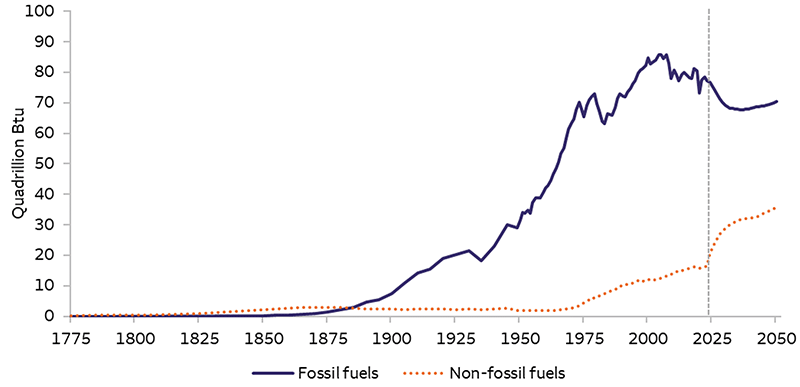 Sources: U.S. Energy Information Administration (EIA), Wells Fargo Investment Institute. Annual data is from 1775 – 2050. Btu = British thermal unit. EIA forecasts are from the 2023 Annual Energy Outlook. Fossil fuels include coal, natural gas, and petroleum and other liquids. Non-fossil includes nuclear and renewables.
Sources: U.S. Energy Information Administration (EIA), Wells Fargo Investment Institute. Annual data is from 1775 – 2050. Btu = British thermal unit. EIA forecasts are from the 2023 Annual Energy Outlook. Fossil fuels include coal, natural gas, and petroleum and other liquids. Non-fossil includes nuclear and renewables.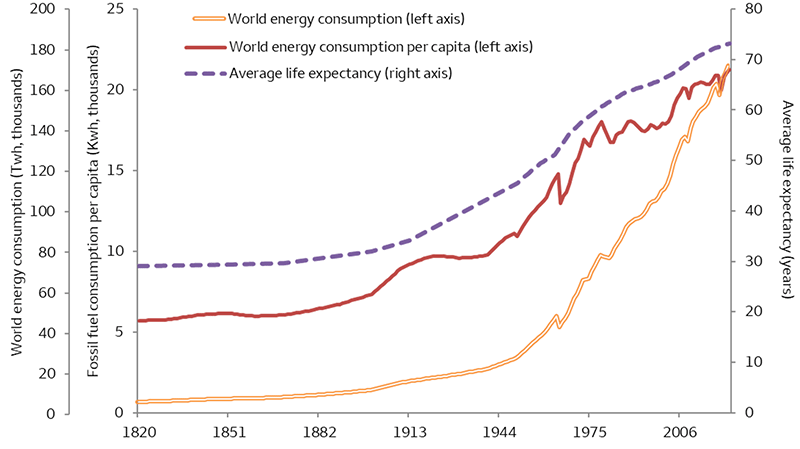 Sources: Our World in Data, BP Statistical Review of World Energy, The World Bank, and Wells Fargo Investment Institute. Annual data from 1820 through 2023. Twh = terawatt hour. Kwh = kilowatt-hour. Per-capita data is calculated by taking consumption data divided by the global population.
Sources: Our World in Data, BP Statistical Review of World Energy, The World Bank, and Wells Fargo Investment Institute. Annual data from 1820 through 2023. Twh = terawatt hour. Kwh = kilowatt-hour. Per-capita data is calculated by taking consumption data divided by the global population.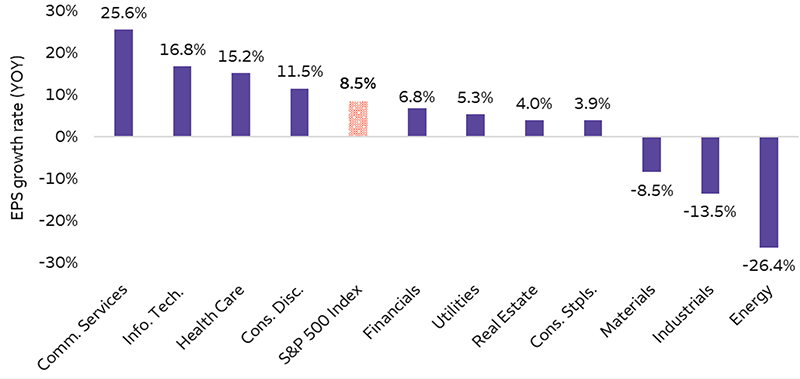 Sources: Bloomberg and Wells Fargo Investment Institute. EPS = earnings per share. YOY = year over year. EPS growth rate measures the year-over-year earnings growth of the S&P 500 Index and each of its sectors, as of November 15, 2024. Orange bar represents S&P 500 Index. An index is unmanaged and not available for direct investment. Past performance is no guarantee of future results.
Sources: Bloomberg and Wells Fargo Investment Institute. EPS = earnings per share. YOY = year over year. EPS growth rate measures the year-over-year earnings growth of the S&P 500 Index and each of its sectors, as of November 15, 2024. Orange bar represents S&P 500 Index. An index is unmanaged and not available for direct investment. Past performance is no guarantee of future results.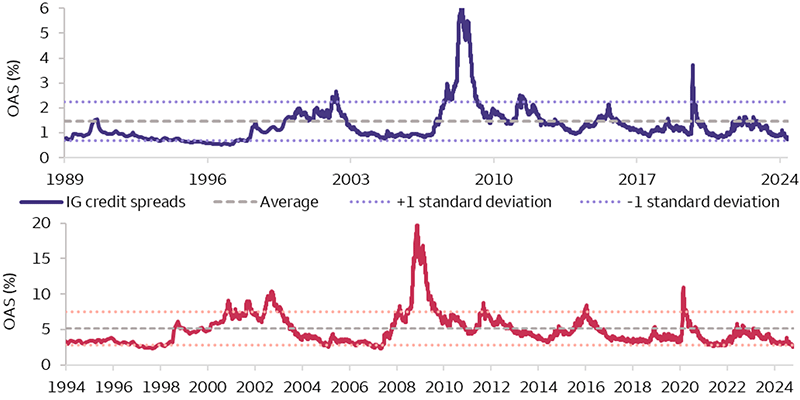 Sources: Wells Fargo Investment Institute and Bloomberg, as of November 19, 2024. Option-adjusted spread (OAS) is the spread relative to a risk-free interest rate. Investment grade (IG) credit spreads represented by Bloomberg U.S. IG Corporate Bond OAS Index. High-yield credit spreads represented by Bloomberg U.S. Corporate High Yield Bond OAS Index. An index is unmanaged and not available for direct investment. Past performance is no guarantee of future results.
Sources: Wells Fargo Investment Institute and Bloomberg, as of November 19, 2024. Option-adjusted spread (OAS) is the spread relative to a risk-free interest rate. Investment grade (IG) credit spreads represented by Bloomberg U.S. IG Corporate Bond OAS Index. High-yield credit spreads represented by Bloomberg U.S. Corporate High Yield Bond OAS Index. An index is unmanaged and not available for direct investment. Past performance is no guarantee of future results.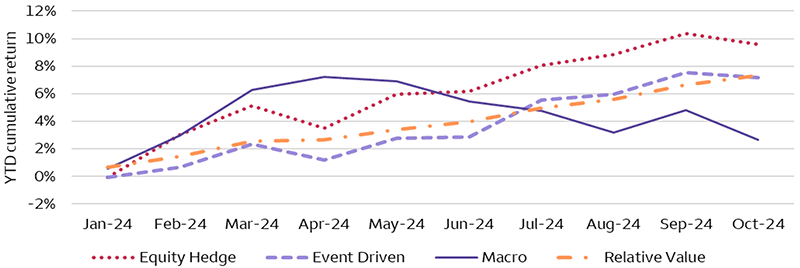 Sources: Wells Fargo Investment Institute, HFRI. Data as of October 31, 2024. YTD = year to date. Equity Hedge = HFRI Equity Hedge (Total) Index. Event Driven = HFRI Event Driven (Total) Index. Macro = HFRI Macro (Total) Index. Relative Value = HFRI Relative Value (Total) Index. An index is unmanaged and not available for direct investment. Past performance is no guarantee of future results.
Sources: Wells Fargo Investment Institute, HFRI. Data as of October 31, 2024. YTD = year to date. Equity Hedge = HFRI Equity Hedge (Total) Index. Event Driven = HFRI Event Driven (Total) Index. Macro = HFRI Macro (Total) Index. Relative Value = HFRI Relative Value (Total) Index. An index is unmanaged and not available for direct investment. Past performance is no guarantee of future results.